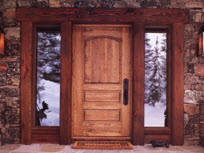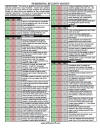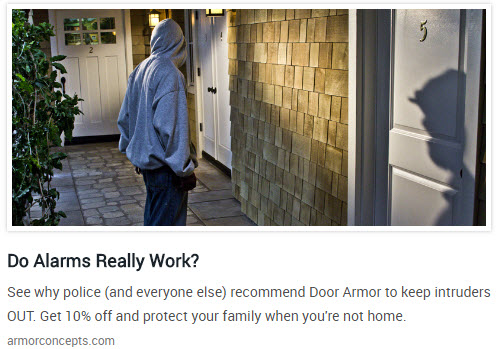Refuse to be a Victim: Defense-in-Depth for the Home
Staying safe in your own home should be a pretty straight forward process. Go inside, lock the doors, and be safe. Youíre not overly worried about an invasion while youíre at home, right? And if you leave lights on while youíre not at home, then that should deter most criminals, right? Donít bet on it! Even in good neighborhoods these day, homes are being invaded and violent crimes committed in areas where we never thought we had to worry about such things. The criminals are taking their show on the road and selecting neighborhoods where they know they can walk away with your valuables.
Criminals have found more ways to break into homes, and more ways to bypass what we think are the normal protective measures, such as locked doors and windows. They are also no longer limiting their invasions to times when they think the home is empty. Invading a home while the occupants are there (see link at the end of this article) has afforded criminals several opportunities for committing even more serious crimes such as kidnapping, rape and robbery. If they can abduct a person who can take them to an ATM to obtain cash, their reward from the crime becomes even greater. Likewise, if someone is home, then they can possibly force them to open safes, unlock secured storage, or gain access to other valuables. So as criminals get cleverer about their strategies, we also need to become craftier with our defenses. And this doesnít mean that we have to turn our homes into hardened fortresses where everyday life is uncomfortable. We just need to find ways to be more aware and have multiple methods of protection.
This is where a term known as ďdefense-in-depthĒ comes in. If you create multiple layers of protection around you and your family to defend against potential invaders, then the chances of a criminal successfully getting in and doing you harm is greatly reduced. The idea here is that even if one or more layers of your defense are defeated, you will still be protected because there are other layers of protection in place to stop the attacker from getting in. Multiple layers of protection will also allow you to be more flexible in your protections while allowing you to still live your life. Remember Ė the idea isnít to barricade yourself inside an impenetrable fortress and have not a life. The goal is to have a safe place of residence and still be able to live comfortably.
Attitude & Awareness: A secure attitude is the very first and most important building block of your home security strategy that you should develop. Just being aware of what is around you, and what condition your other security measures are in is really all weíre talking about here. Keeping the mind set of always locking doors (even during the day) and always being aware of your surroundings will go a long way towards ensuring your safety. Obviously you canít be in a heightened state of awareness all the time. You like to sleep occasionally, right? But thatís where having multiple layers of protection will come into play, as we will discuss further in this article. And the importance of this attitude is to realize that you are not doing these things because you are afraid, you are doing them to protect yourself and your family.
Exterior Areas: Keep bushes and shrubs trimmed Ė donít give criminals a place to hide. Find some attractive "thorny" bushes to put in front of your windows. Donít leave tools and ladders outside and accessible where someone can use them to break into your home. Keep outside areas well lighted. Consider installing motion detectors for turning on outside lights when someone enters the area leading up to your doors. Make sure the garage door is closed. If you have large dog doors, make sure they are secured when not in use. When you come home, make sure you are aware of what's going on as you enter the house. If anything seems out of place upon your arrival home, leave the area immediately, go to a neighbor's house, and call 911.
 |
|
Large windows on the sides of |
Exterior Facing Door Areas: Install wide-angle peep-holes to allow you to see more area of the outside entry way. Covering windows that allow people to look inside is an important step in foiling would-be home invaders also, especially if you have an alarm system with a control panel that is visible in the front or rear entry areas. For example, some people have large windows on either side of the entry door that allows someone to view into the house. Many alarm installers will put the control panel for the alarm system adjacent to an entry door. If a potential intruder can peer in and see the alarm status lights, then they know whether or not your alarm system is even armed. Consider putting curtains or opaque window film over these windows. There are many attractive options that will still allow light to come in, but will make it very difficult for people to see details about the inside of your entry areas.
Alarm Systems: Consider installing an electronic alarm system with battery backup, connected to a centrally monitored alarm company via telephone. These types of alarm systems are very affordable, and can also detect smoke/fire and carbon monoxide, making them extremely effective in several different aspects of home security. Panic buttons are a popular feature of these alarm systems. A panic button can be hard mounted on a wall, but can also be a wireless device, and portable, resembling a key fob. Not only can you use the wireless devices to alert the alarm company in a panic situation, but they can also be used to arm and disarm your alarm system from anywhere in the house. These types of alarm systems can be very sophisticated, and allow you all sorts of options such as glass break detectors, motion detectors, and sensors to detect if windows are opened. The options are many and varied for these systems.
 Dogs and Signs: Even if you donít have an alarm system, a sign warning potential criminals can still be effective. They donít know that you donít really have an alarm, but such a sign makes them think that you do, and therefore they perceive that they have a higher risk by breaking into your home. This may be enough to make them bypass your house and look for an easier target (deterrence is another layer of defense). Likewise, even if you donít have a dog, there are companies such as DutchGuard that make motion detecting devices that will emit a very realistic dog bark. Of course, actually having a big dog in the house will serve as a powerful deterrent. And if a potential intruder peers into the house and sees a large set of food and water bowls laying by the entry, that may be enough to give them reason to look elsewhere for an easier target. Even if you donít have the big dog, put a set of food and water bowls meant for a large dog near interior areas visible to the outside.
Dogs and Signs: Even if you donít have an alarm system, a sign warning potential criminals can still be effective. They donít know that you donít really have an alarm, but such a sign makes them think that you do, and therefore they perceive that they have a higher risk by breaking into your home. This may be enough to make them bypass your house and look for an easier target (deterrence is another layer of defense). Likewise, even if you donít have a dog, there are companies such as DutchGuard that make motion detecting devices that will emit a very realistic dog bark. Of course, actually having a big dog in the house will serve as a powerful deterrent. And if a potential intruder peers into the house and sees a large set of food and water bowls laying by the entry, that may be enough to give them reason to look elsewhere for an easier target. Even if you donít have the big dog, put a set of food and water bowls meant for a large dog near interior areas visible to the outside.
Safe Room: Have more than one safe room, if possible. The safe room in many homes is a master bedroom because that is where many people keep their gun safes, and have other necessities such as a bathroom, water, and other comfort items in case they will be there for several hours. If your safe room is something such as a master bedroom, consider changing out the small screws for the door hinges and latch plate with the longer three-inch screws to make the door harder to break down. Install a solid core door if possible. Install key-lockable entry locks on the safe room entry door. Make sure your safe room has a phone (both landline and cell phone, if possible). If you have firearms for home defense, make sure they are in the safe room area. Have one of those remote alarm control device with a panic button, as mentioned above. Make sure all of your family members know where the safe room is. Have a code word that you use to tell everyone to get to the safe room quickly in an emergency.
If an intruder does break in, and you have all of your family members safely inside the safe room, STAY THERE! Dial 911, activate your panic button, and keep emergency services on the line until help arrives. Keeping them on the line is especially beneficial if you have a firearm as part of your home defense strategy. They are able to hear you as you warn the invaders that you have a firearm and that you will shoot them if they enter your safe room. This warning is recorded by the 911 operator, and may be helpful in the follow-up investigation, especially if you are forced to use your firearm for self defense.
Security Accessories: Make sure and keep additional items that will help you in various areas throughout the house. Flashlights with extra batteries can be kept in multiple places throughout the house. Your cell phone should be with you. Even keeping those old, un-used cell phones handy and charged up can be used. Even if a cell phone isnít activated with an account, you can still make 911 emergency calls from them. A remote alarm system controller with a panic button is highly recommended if you have an alarm system installed. Pepper sprays and other non-lethal self defense items can also be beneficial. Also keep a first aid and 72-hour kits in your safe room.
Warning: Any of the practice drills mentioned below should be done with an unloaded firearm. Remove ALL live ammunition from the area before performing any practice drills. Use only unloaded firearms when practicing. Check and double-check your firearm to make sure it is unloaded before attempting any drills or practice in the home.
Drills and Practice: Hopefully you already have fire drills in your home. But do you ever have a home invasion drill, possibly even in the middle of the night? Try it some time, and ask yourself the following questions to identify potential areas where you need to develop a strategy:
-
Does everyone know where to go?
-
How long does it take them to get there?
-
Would anyone have to get to the safe room by first going through a part of the house that might be occupied by the potential intruder?
-
If you have a child in another part of the house, away from the safe room, how do you venture through the house to get to that child to ensure their safety.
-
Do you have a defensive firearm? Do you know how to gain access to it, even in the dark?
If you have a defensive firearm in a handgun safe, for example, drill yourself on how much time it takes to get into the safe, access your firearm and other essential tools such as a flashlight. Do this both in the light, and in the dark.
Wrapping It All Up: Even if someone does break in and takes your property, property can be replaced. Thatís what insurance policies are for. The purpose of having a home defense strategy is to keep you and your family members safe in case of a home invasion. The purpose of a home defense firearm should always be that it is the last line of defense in an attack, and then used ONLY to stop the attack. There are many layers that you can employ for your home defense strategy.
The home defense methods mentioned in this article are only some of the home defense techniques that can be used. The NRAís nationally recognized ďRefuse To Be a VictimĒ seminar taught by Northern Colorado Firearms Safety Training will give you a well rounded self defense strategy. We include information on keeping your home safe, staying safe while out and about, safety while traveling, and even safety while using your computer online. See our scheduling for an upcoming class, or ask us about private instruction.
For More Information: For a more complete self-assessment of your own home security, download this document. It is published by the Jefferson County, Colorado Sheriff's office, and can be used to help you assess your own home security and find out which areas need attention.
Follow Up: 1/8/11 - Just as I was finishing writing this, I saw the following article in which men with shotguns burst into an occupied home at 9:30pm demanding money:
Article: Home Invasion Suspects Arrested
About The Author: "The Gonz" is an NRA Certified Firearms Instructor (Pistol, PPiTH, RTBAV), US Concealed Carry Association Affiliate Instructor, and an NRA Certified Range Safety Officer. Additionally, he a trained and certified Community Emergency Response Team (CERT) member, with several years of training in the Incident Command System (ICS) procedures and practices.
Become an Armor Concepts Advocate and Make Money on Referrals




